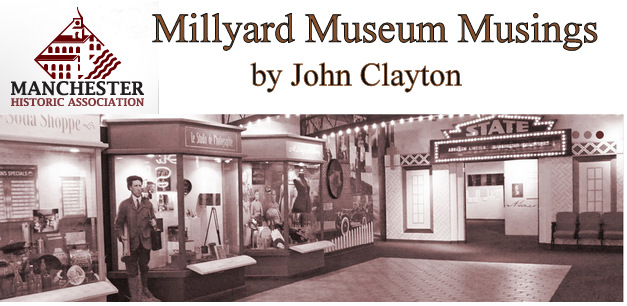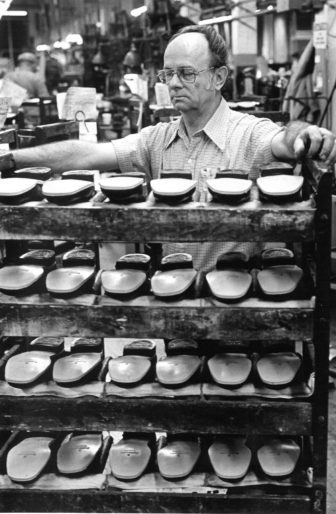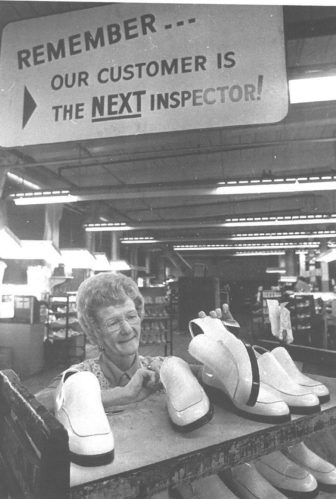
It’s not like people are walking around barefoot, but the fact is, if you’ve been looking for a pair of American-made shoes, good luck to you.
Go look for yourself. At the risk of mixing a metaphor, American shoes are as rare as steak tartare. They’re harder to find than the sunken city of Atlantis, a situation that was unfathomable (sorry) in Manchester as recently as 20 years ago.
In technical economic terminology, Manchester-made shoes kicked butt on a global scale for the better part of a century, but – as if to punctuate the industry’s precipitous decline – back in 1994, they closed the local office of the United Shoe Workers of America.
”Everybody in the country still wears shoes,” local USWA field rep Fred Nugent told me back then, ”we just don’t make them anymore. They passed a bunch of trade laws in the 1960s and 1970s, then we got swamped by imports and the foreign competition killed us. We let thousands of jobs get away from us.”
To understand what’s been lost, it’s best to go back to the beginning, and according to the Manchester Board of Trade Journal, ”The year 1885 marks the beginning of the shoe manufacturing industry in Manchester.”

That’s the year the Kimball Bros. Co. set up shop in the red brick block at Cypress and Massabesic streets. Today, most folks remember the place as the former home of Salvage Shoe, but way back when, the Kimballs started with 150 workers and before long, they were producing 700,000 pairs of shoes per year.
In no time, the city was plastered with shoe shops. The first one to make its mark on the West Side was Crafts & Green Shoe Factory at the juncture of Second and West Hancock streets. Today, it’s better known as the home of OutFITters Thrift Store.
Over on Silver Street, the place we know today as Twin Towers got its start in 1892 as the F.M. Hoyt Co., manufacturer of trendy Beacon Shoes whose name still adorns the brick smokestack on the grounds. Over on Page Street lies the Eaton Heights Shoe Shop (est. 1898) which served most recently as the City Recycling Center. In time, they even made shoes on Bass Island – no, not Bass Weejuns – when the island was home to Sibulkin Shoe.
The granddaddy of them all, however, was the W.H. McElwain Shoe Co., the sprawling complex on what we now know as Sundial Avenue. While the building itself has gone through more lives than Shirley MacLaine – it was home to Lamex Chemical, then Foster Grant, then Hussey Moldings and now it’s home to Mount Washington College – when its doors opened in 1912, it was ”largest single shoe factory in the whole United States.”
To prove it, the McElwain public relations staff worked overtime cranking out silly statistics. Every year, half a million cattle surrendered their souls to make soles for their shoes, so many that ”these cattle, walking in procession head-to-tail, would make a line 800 miles long.”

McElwain did more than $16 million in sales that same year, and to do so, the firm used the hides of another 2.4 million cattle for ”leather uppers,” and, lest we forget, ”the shoelaces used in a year, all put in a line, would run from Boston to Yokohama via San Francisco.”
By all accounts, the owners of W.H. McElwain were well-heeled. They held company outings, sponsored company bowling teams (like the Heelers, the Cutters and the Counters) and subsidized a company cafeteria where Helen Siebold – the ”Shoe Shop Chef” – served 2,300 meals every day.
Those ”wholesome, three-course meals” could be had for a mere 25 cents. The only problem? Twenty-five cents wasn’t far from a day’s pay back then.
Yes, it’s true. Not all of the heels were on the shoes. There were heels in the front office too. At the risk of making this read like the scribblings of a left-leaning Bolshevik defending the rights of the proletariat, workers were exploited shamelessly in many of the shoe shops.
By some estimates, the Manchester shoe shops employed up to 20,000 workers. Except for the ones they made, there wasn’t a loafer in the lot.
”You couldn’t loaf,” said Marge Lamper, who also worked as a cashier on the caterpillar ride at Pine Island when she wasn’t making shoes. ”The day you started, they told you the door opened both ways. You could go out as fast as you came in. That’s what they always told us, and there was a line of people outside just waiting for your job.”
The line of workers was almost as long as the list of companies that called Manchester home. There was Eno & Blood and Shortell Shoes, not to mention Selby and Gentstil and Ayer & Williams. There was Evangeline and Salvage and Dorson and Fleisher and Dorson & Fleisher. There was J.F. McElwain and Gutman-Kesslen and Bee Bee and Behr-Flex and Derryfield and Johnson and hey, let’s not forget Myrna, where the demand for production was occasionally comical.
”One day they told me I wasn’t moving fast enough, so the next day I came to work on roller skates and I wore them all day,” laughed Nancy Chalifour, a typical jack-of-all-trades who even put the bows on the toes when they made ladies’ shoes.
In this business, there was a job and a title for everyone. Ralph Montplaisir was a rough-rounder. May Keefe was an odd-shoe girl. Leon Lamper was a last puller. Athena (Argeropoulos) Bobotas was a double-needle stitcher. Nick Lambrou was a leather cutter and his wife, the late Fannie (Dakoulas) Lambrou? She had the best job of all.
”I was a shoe model,” Fannie said. ”I had a perfect size four. I also had a high instep, so if my foot would fit into a shoe, they figured it would fit anyone. Besides, when the salesmen had to carry cases of samples, they always wanted to carry smaller shoes.”
As a fringe benefit, she kept what she modeled.
”Even today, it kills me to pay for a pair of shoes,” she said back then.
While there are those who would argue that the shoe shops were a professional dead-end, there were a few notable exceptions.
One salesman for the F.M. Hoyt Shoe Co. was a fellow named A.B. Jenks. All he did was get himself elected to Congress in 1938. Then there was Joe Jason. He used to spend his lunch hour selling rings and bracelets to his co-workers at Derryfield Shoe until he went out on his own and started his own business – Jason’s Jewelers.
In the end, the only dead end was the one that confronted the industry itself. For memories, you might want to check out the Millyard Museum’s ”Made in Manchester” exhibit to see some tools of the trade.

John Clayton is Executive Director of the Manchester Historic Association. You can reach him with your historical (or existential) questions at jclayton@manchesterhistoric.org.
 You’re one click away! Sign up for our free eNewsletter and never miss another thing
You’re one click away! Sign up for our free eNewsletter and never miss another thing







